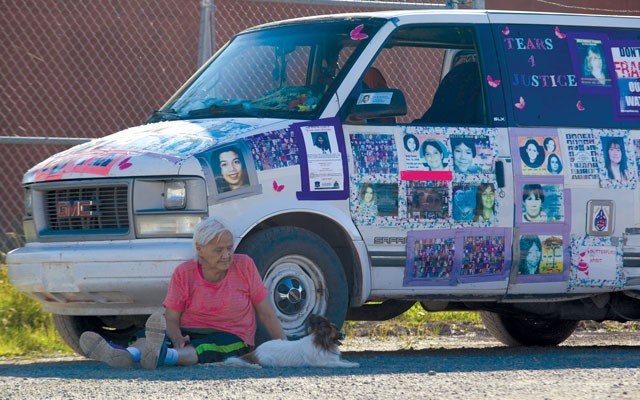There's a moment in the documentary Walk when the most heart-wrenching kind of recognition takes place.
"That's my daughter," says one mother tearfully, touching a photo of a young smiling woman on a van covered in the images of many dead or missing loved ones.
Tears and a grief-stricken hug follows — a moment of intimacy with cameras capturing it from a distance.
"One of my worst fears is that they will be forgotten, that they will be brushed under the rug," she says.
The van (pictured above) is the focal point for six walkers who spent over half a year crossing Canada in 2014 in order to spread awareness of the crisis of missing and murdered Indigenous women.
Walk's producer and director, Robert Colbourne of Diamondhead Films, joined the walkers to tell their stories, and through them, the stories of the missing and murdered, as the walkers made their way across British Columbia on the final leg of their journey.
"They started in Halifax in the spring and we picked them up in the fall in Prince George, and we followed them for 15 days to Prince Rupert," Colbourne says.
It ultimately took three years to complete the film.
"It's a hard thing to do. It takes its toll on you in many ways. You are exposed to so much, and yet there is so much we didn't put in the film," he says.
"We interviewed government people and MLAs and all that stuff, but when it came to editing, it's the people's story and I wanted them to tell it. I didn't want a government head telling their version of it."
Colbourne splits his time between Diamondhead projects and his work at CTV Vancouver, with documentary making allowing him to explore stories a little deeper.
Looking at this particular story was important to him, he says.
"It's frustrating, even as I work in the media, seeing a story like this that doesn't get enough attention," he says.
"People ask me how I started this film, and it came first with the disappearance of Nicole Hoar (in 2002), and you look at it and think, 'Wow! This has been going on for four decades. Why haven't we heard of this?'
"I think that is indicative of a larger problem."
With the walk largely neglected by most Canadians, Colbourne said going from Indigenous community to Indigenous community was the only way the walkers would succeed.
"It's the only segment of the population that supports them on this. There was really no news stories about the walk," he says.
"I didn't know about it, and I work at CTV. I wanted to talk about it more."
Whistler plays heavily in the making of Walk, with executive director Lawrence Black (owner of Black's Pub) involved, Colbourne a part-time resident, and many crewmembers from Whistler taking part.
As a filmmaker, he wanted the narrative of Walk to follow human beings not statistics.
"I want to show the hole that it leaves in these people's lives and how it effects generations to come. These people seem like a number on the news, but each one of these victims have people who love them," he says.
Asked what he felt the walkers learned and gained from the experience, Colbourne says he felt the trip was somewhat cathartic and healing for them.
"As a way to get out, to try to search for answers in a way. This whole process is a form of healing, not just for the walkers themselves, but also for the communities they visited, because every single one of them has been touched by violence," he says.
One of the most poignant things Colbourne found in the process of research and interviewing, he says, is that he didn't find a single First Nations person that hadn't been hurt by violence one way or another.
"Directly touched by it. Has a family member missing, or a brother or sister harmed. It's unbelievable. When you look at our non-Indigenous families, we don't have that. I don't know any of my friends who has had someone murdered," Colbourne says.
"People have said to me, 'But this an Aboriginal story.' It's not an Aboriginal story. It's a Canadian one. This is a Canadian issue.
"We need to do better."
Colbourne says they are hoping to screen Walk in the coming months, and can't wait to show it in Whistler since so many locals worked on it.




